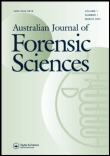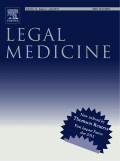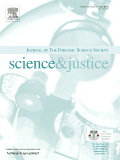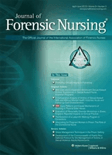
Australian Journal of Forensic Sciences
Scope & Guideline
Empowering Forensic Professionals with Essential Research
Introduction
Aims and Scopes
- Forensic Methodologies and Techniques:
The journal emphasizes research on new and improved forensic methodologies, including DNA analysis, fingerprint detection, and imaging techniques, which are critical for accurate forensic investigations. - Application of Forensic Science in Legal Contexts:
A consistent focus is placed on how forensic science impacts the legal system, with studies exploring the reliability of forensic evidence in court proceedings and its role in criminal investigations. - Interdisciplinary Research:
The journal encourages interdisciplinary approaches, integrating knowledge from fields such as biology, chemistry, and digital forensics to enhance the scientific basis of forensic practices. - Population-Specific Studies:
Research addressing forensic characteristics within specific populations is highlighted, contributing to the development of localized forensic standards and practices. - Ethical and Social Implications of Forensic Science:
The journal also addresses the ethical considerations and societal impacts of forensic practices, ensuring a holistic view of the discipline.
Trending and Emerging
- Digital Forensics and Cybersecurity:
A notable trend is the increasing focus on digital forensics, including the analysis of digital devices and data, which is becoming crucial as crime increasingly involves technology. - Machine Learning and AI Applications:
The integration of machine learning and artificial intelligence in forensic analysis is gaining prominence, showcasing innovative approaches to data interpretation and evidence analysis. - Environmental Forensics:
Research addressing the intersection of forensic science and environmental issues, such as the effects of pollutants on forensic evidence and the use of ecological indicators in investigations, is emerging as a significant area of interest. - Forensic Genetics and Ancestry:
An increasing number of studies focus on forensic genetics, particularly in relation to ancestry determination and the application of genetic data in forensic contexts, highlighting the relevance of genetic diversity in forensic identification. - Sustainability in Forensic Practices:
There is a growing interest in sustainable practices within forensic science, including the development of eco-friendly materials and methods, reflecting a broader societal focus on environmental responsibility.
Declining or Waning
- Traditional Forensic Anthropology:
Research specifically focused on traditional forensic anthropology methods has waned, possibly due to the rise of more advanced imaging and analytical techniques which provide more precise results. - Basic DNA Profiling Techniques:
There is a decline in studies centered on basic DNA profiling methods, as the field has moved towards more complex and innovative approaches, such as next-generation sequencing and bioinformatics. - Generalized Forensic Science Reviews:
The frequency of generic review articles summarizing forensic science practices has decreased, indicating a shift towards more specialized, detailed studies that address specific forensic challenges. - Localized Case Studies:
The journal has seen a reduction in case studies that do not incorporate broader forensic principles or methodologies, suggesting a move towards integrating findings with broader implications for forensic science.
Similar Journals

Legal Medicine
Exploring the intersection of health and justice.Legal Medicine, ISSN 1344-6223, published by ELSEVIER IRELAND LTD, stands as a pivotal academic journal within the realms of forensic medicine and legal ethics. Operating from the Netherlands, this journal has established a strong reputation among researchers and practitioners since its inception in 1999, with the goal of advancing knowledge in the intersection of legal and medical disciplines. With a commendable Q2 categorization in both Issues, Ethics and Legal Aspects and Pathology and Forensic Medicine, it ranks among the noteworthy publications in these fields, placing it in the 51st percentile for Pathology and Forensic Medicine and 51st for Nursing-related ethical issues. The journal not only serves as a repository for innovative research and practical case studies but also emphasizes the importance of ethical considerations in medical legal scenarios. Although it does not offer Open Access options, it remains a crucial resource for professionals, researchers, and students seeking to stay informed about the latest developments that shape legal medicine. Access to its contents promises to enhance understanding and inspire advancements in both forensic science and the ethical frameworks surrounding them.

Egyptian Journal of Forensic Sciences
Pioneering insights in forensic science and law.The Egyptian Journal of Forensic Sciences, published by the International Association of Law & Forensic Sciences, stands as a premier platform for scholarly communication in the fields of forensic science, law, and health-related social sciences. With an ISSN of 2090-536X and an E-ISSN of 2090-5939, this open-access journal, established in 2011, has garnered a reputation for its rigorous peer-review process and substantive contributions to the field. Housed in Switzerland, it boasts impressive metrics, achieving a Q2 ranking in Health (social science) and a stellar Q1 in Law, in addition to being recognized in Pathology and Forensic Medicine. With its articles accessible to a global audience, the journal encourages the exchange of innovative ideas and practices among researchers, professionals, and students who are dedicated to advancing the disciplines of forensic science and legal studies. As of 2023, it ranks in the 75th percentile in Social Sciences - Law and continues to influence both academic discourse and practical applications in the forensic domain.

INTERNATIONAL JOURNAL OF LEGAL MEDICINE
Elevating Standards in Legal Medicine ResearchINTERNATIONAL JOURNAL OF LEGAL MEDICINE, published by SPRINGER, stands at the forefront of research in the fields of legal medicine, pathology, and forensic science. With an ISSN of 0937-9827 and an E-ISSN of 1437-1596, this esteemed journal has successfully maintained its reputation as a leading publication since its inception in 1990, providing a platform for the dissemination of cutting-edge research and case studies. The journal is recognized as a Q1 category publication in the 2023 Pathology and Forensic Medicine quartiles, ranking #44 out of 208 in its category on Scopus, reflecting its significant contribution to the academic community—demonstrated by its impressive 79th percentile. While the journal operates under a traditional subscription model, it is committed to enhancing access to critical insights in legal medicine. The INTERNATIONAL JOURNAL OF LEGAL MEDICINE invites researchers, professionals, and students to explore its manuscripts that shed light on the intersection of law and medicine, thus pushing the boundaries of what is known in these vital fields.

MEDICINE SCIENCE AND THE LAW
Exploring Ethical Frontiers in Medicine and LawMEDICINE SCIENCE AND THE LAW is a prestigious journal published by SAGE PUBLICATIONS INC, focused on the intersection of law, health policy, and ethical issues as they pertain to medicine. With a long-standing history dating back to 1960, this journal has become a crucial platform for scholars and professionals alike to share and disseminate research that shapes the evolving legal landscape surrounding health care practices. It holds notable positions in the academic community, ranking in the Q3 category for Health Policy and Issues, Ethics and Legal Aspects, and achieving a distinguished Q1 ranking in Law as of 2023. With rigorous peer-review standards and a commitment to publishing high-quality research, MEDICINE SCIENCE AND THE LAW is invaluable for those exploring the critical legal challenges and ethical dilemmas faced within the healthcare sector. Research contributions are vital for informing policy and practice, ensuring that the journal remains a relevant and essential resource for researchers, practitioners, and students dedicated to the intersection of law and medicine.

Anil Aggrawals Internet Journal of Forensic Medicine and Toxicology
Empowering Knowledge in Toxicology and LawAnil Aggrawals Internet Journal of Forensic Medicine and Toxicology, an esteemed publication in the field of forensic medicine and toxicology, is dedicated to disseminating innovative research and critical insights since 2000. Published by ANIL AGGRAWALS INTERNET JOURNAL FORENSIC MEDICINE & TOXICOLOGY, the journal caters to professionals, researchers, and students keen on advancing their understanding of forensic science, including its intersections with law and public health. Although it currently holds a Q4 quartile ranking in Law, Pathology and Forensic Medicine, and Toxicology, the journal provides a vital platform for underrepresented studies, encouraging a diverse range of scholarly contributions. With its open access model, the journal enhances visibility and accessibility, ensuring that valuable research can reach a wider audience. As the journal continues to evolve, it plays a crucial role in bridging theoretical knowledge and practical applications, thereby enriching the discourse within its fields of study and fostering inter-disciplinary collaborations.

Rechtsmedizin
Pioneering Research in Forensic PathologyRechtsmedizin is a prestigious academic journal published by Springer, focusing on the critical field of forensic medicine and pathology. With a legacy dating back to 1995, this journal serves as a vital platform for disseminating advanced research and clinical findings that enhance the understanding of legal medicine and forensic science. Although it currently does not offer open access, it boasts an impressive Q3 ranking in 2023 within its category, indicative of its contribution to the field, with a Scopus rank of #149 out of 208 in Medicine, placing it within the 28th percentile of its peers. As a dedicated resource for researchers, professionals, and students, Rechtsmedizin aims to bridge the gap between clinical practice and forensic investigation, promoting the integration of scientific advancements into everyday applications within the legal context. With its location in New York City, USA, the journal remains a key player in the global discourse on forensic issues, thus inviting submissions that push the boundaries of traditional forensic methodologies and explore innovative approaches in legal medicine.

Forensic Chemistry
Empowering forensic investigations with analytical precision.Forensic Chemistry is a premier journal published by Elsevier, specializing in the interdisciplinary field of forensic science, with a strong emphasis on analytical and materials chemistry, pathology, and law. Established in 2016 and converging to a significant publication trajectory through 2024, the journal has rapidly ascended to an impressive Q1 ranking across multiple categories, demonstrating its impact and commitment to advancing forensic analysis and methodologies. With an impact factor reflecting its relevance—especially notable with a 95th percentile rank in Social Sciences and Law—Forensic Chemistry serves as an essential resource for researchers, legal authorities, and academics seeking to explore the latest developments in forensic techniques and applications. Its rigorous peer-review process and high-quality publications ensure that it remains at the forefront of scientific inquiry in forensic practices. Access to the journal is available without an open access model, further emphasizing its commitment to curated, high-impact scholarship that contributes to both theoretical foundations and practical applications in the forensic field.

Proceedings of the Institution of Civil Engineers-Forensic Engineering
Advancing Safety Through Forensic InsightsProceedings of the Institution of Civil Engineers - Forensic Engineering is a pivotal journal in the field of forensic engineering, published by Emerald Group Publishing Ltd, a renowned name in academic publishing. With a focus on investigating and understanding the failures of civil engineering structures, this journal provides a critical platform for the dissemination of research and case studies aimed at enhancing safety, risk, and reliability in engineering practices. It holds an important place in the Q4 quartile of the Safety, Risk, Reliability and Quality category as of 2023, and currently ranks #123 out of 207 in its field according to Scopus, reflecting its emerging influence despite its relatively recent establishment in 2011. Researchers, practitioners, and students alike will find valuable insights through non-open access articles that contribute to a deeper understanding of forensic analysis in civil engineering contexts. The journal's mission is to promote discussions that lead to significant advancements in civil engineering safety and reliability, ultimately informing best practices and policy-making in the profession.

SCIENCE & JUSTICE
Pioneering Research for a Just and Equitable Society.Science & Justice is a leading international journal published by Elsevier Science Ltd, dedicated to the interdisciplinary examination of the intersection of justice and science, especially within the realms of forensic science and pathology. Established in 1995, this reputable journal has garnered a commendable Q2 rank in the category of Pathology and Forensic Medicine, reflecting its significant contributions to advancing knowledge in these critical fields. With an ISSN of 1355-0306 and an E-ISSN of 1876-4452, the journal is indexed in Scopus, positioning it in the top 68th percentile among its peers. The objectives of Science & Justice include promoting research that bridges scientific methodologies with justice-related applications, making it an invaluable resource for researchers, professionals, and students alike. As the journal continues to evolve, it aims to interface scientific innovations with forensic practices, thereby enhancing the integrity of justice processes globally. Despite not offering Open Access options, it remains a pivotal reference point within the academic community focused on forensic science methodologies and their legal implications.

Journal of Forensic Nursing
Bridging Nursing, Law, and Science for ImpactThe Journal of Forensic Nursing, published by Lippincott Williams & Wilkins, stands as a pivotal platform for the dissemination of research and discourse at the intersection of nursing, law, and forensic sciences. With an ISSN of 1556-3693 and an E-ISSN of 1939-3938, this journal caters to a multidisciplinary audience, including researchers, practitioners, and students committed to advancing the field of forensic nursing. Spanning topics related to issues, ethics, and legal aspects of nursing and forensic medicine, the journal is categorized in the Q3 quartile for several fields, indicating its growing relevance and impact as a scholarly resource. Converging years from 2005 to 2024, it reflects ongoing innovations and challenges within these domains. While not an open-access journal, the research published herein significantly contributes to the nuanced understanding of both patient care and the intricacies of legal frameworks affecting vulnerable populations. In a landscape where forensic considerations increasingly permeate health care, this journal is a crucial resource for those seeking to enhance their knowledge and practice.